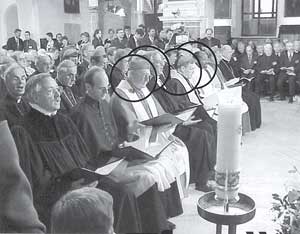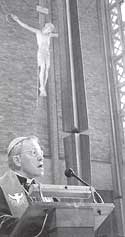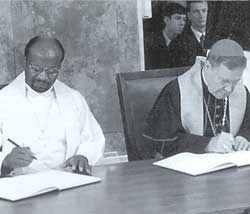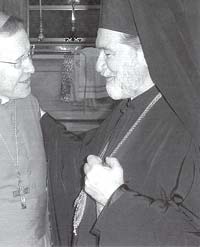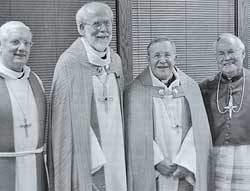

![]()
![]()
|
June 2005 Reprint #64
Kasper's intervention was published in its entirety in L'Osservatore Romano1 and stands for us as a precious document for identifying the theological outlook of the current ecumenical movement and its foundation in the theses of the Second Vatican Council, as amply developed and applied during the papacy of John Paul II. In this regard one cannot fail to appreciate the great clarity of Cardinal Kasper. What the President of the Council for Promoting Christian Unity fails to do-what is in fact his duty-is to recognize the sometimes irrelevant, at other times contrasting relationship of the positions of the “Conciliar Church” to the universal ordinary Magisterium of the Catholic Church. On the contrary, as we shall see, the cardinal takes it upon himself to conceal this contrast.
The Council's A Priori
Before examining the content of Cardinal Kasper's intervention it will be helpful to outline its structure. Cardinal Kasper insists repeatedly on certain statements, which he presents as evident and well-founded assumptions when they are not. In fact, at the beginning of his speech we find the following: “The pope has repeatedly confirmed that the ecumenical path is irreversible (Ut Unum Sint, §3 [hereafter referred to as UUS]).” And likewise in closing the cardinal sums up: “The decree [Unitatis Redintegration hereafter referred to as UR]gave the impetus to an irrevocable and irreversible process, for which no realistic alternative exists. The Decree on Ecumenism shows the path of the 21st century. It is the will of the Lord [sid] that we undertake this path....” These two peremptory assertions, which open and close the speech, should not be dismissed with too much haste. They constitute the indispensable key to understanding the basis of the current teaching: they are the alpha and omega that illuminate the current crisis of the Church. Let us recall the context in which the speech was delivered: the cardinal was addressing the principle “ecumenical agents,” Catholic and not. And what did he tell them? We have read it: the ecumenical path, as inaugurated by the Conciliar decree, is irrevocable; indeed, it is irrevocable and irreversible, which is to say that it cannot be changed in any way, nor can the direction it has taken be altered. In this way the cardinal would strangle at birth any attempted reorientation from a traditional perspective, stigmatizing it as unrealistic. The one solution that the popes had uninterruptedly proposed is absolutely banished and discredited: “The goal of ecumenism cannot be conceived as a simple return of others to the bosom of the Catholic Church.” Kasper's affirmation is opposed to the universal magisterium of the Church as its contradiction: “There is but one way in which the unity of Christians may be fostered, and that is by furthering the return to the one true Church of Christ of those who are separated from it.”2 The true “dogma” proclaimed by the Council is this new ecumenical path. More precisely, the new ecumenism is the premise that undeniably underlies the teachings proper to Vatican II and the theology of the current pontiff. The key texts of the Council were based on this premise. This is not our assertion: Cardinal Kasper himself demonstrates it with the texts of the Council and the encyclicals of John Paul II in hand. Since the new ecumenical path-the content of which we shall examine in a moment-is supposed irrevocable, it has been found necessary to re-examine and restructure Catholic ecclesiology in a non-Catholic manner. As has been observed: This a priori determination, which has no legitimate point of reference, is the heart of the Conciliar text that affirms that the Church of Christ “subsists in” the Catholic Church. This is in fact the only thing that the Council teaches in a clear manner: its ecumenical will. It is not ecumenical as an echo of the constant and universal teaching of the Church, but because it has established as the basis of its theories a clearly ecumenical will that lacks any foundation and that the entire prior Magisterium condemns.3 The key elements of this a priori determination as inserted into the documents of Vatican II are essentially three, in Kasper's reckoning: the eschatological perspective of the Church understood as the People of God; the well-known “subsistit m”; and the ecclesiology of communion.
Techniques of PersuasionBefore considering each of these elements analytically, it seems important to emphasize another point on which the cardinal repeatedly insists in his discourse. One should keep in mind the context in which the cardinal finds himself: it is a lecture, that is to say, an intervention that is meant to be heard before it is read. Therefore, probably aware of criticisms of the ecumenism inaugurated by the Council or, even more likely, in order to counterbalance the manifest contradiction of his ecumenical theses to the perennial Magisterium, Cardinal Kasper takes it upon himself to reassure his listeners. He does this with exhalations of nolite timere-have no fear-which represent an attempt at pre-rational persuasion (let us note that at the beginning of the Congress a film was shown, prepared by the Vatican Television Center, showing the “triumphs” of contemporary ecumenism: from the meeting of Pope Paul VI and Athenagoras, to the “restitution” of the icon of the Mother of God of Kazan in Moscow). We present in their order of appearance Kasper's repeated assurances that the new ecumenism is in continuity with Tradition. Unable to make this point by means of arguments, Cardinal Kasper is constrained to resort to persuasive techniques: It would, however, be mistaken to ignore this fundamental continuity and consider the Council as a radical rupture with Tradition and identify it with the advent of a new Church.... Nevertheless, with the Council something new has begun: not a new Church, but a renewed Church—The ecumenical movement did not discard anything that up to now has been precious or important to the Church and its history; it remains faithful to the truth that has been recognized and denned as such throughout history and adds nothing new to it.... As a spiritual movement, ecumenism does not uproot Tradition. On the contrary, it proposes a new and more profound understanding of Tradition....With it is being prepared...not a new Church, but a spiritually renewed and enriched Church. [And finally:] The Council affirms no new doctrine, but motivates a new attitude, it renounces triumphalism.... We now enter into the thick of the issue, in the content of the discourse, in order to verify, this time by rational means, the rupture of today's “ecumenism” with Tradition. It will be shown that it is not the development of “seeds” present within Tradition, but rather a “new doctrine” sic et simpliciter.
Dynamic Eschatology of the Church as People of GodCardinal Rasper's introduction confirms our earlier reflections on ecumenism as the a priori foundation of the new ecclesiology of the Council: “The Council took up the ecumenical movement because it understood the Church as a movement, that is to say the People of God on a journey (Lumen Gentium [hereafter referred to as LG] §§2; end, 8, 9, 48-51; UR§2 end, etc.)” He elaborates:
The Council, therefore, underlining the dynamic component of the Church, recovered the eschatological dimension of the Church. Eschatology is not here understood in the traditional sense, but as a tension between the “already” or the “here” and the “not yet,” as a synonym for the essentially dynamic nature of the Church. Ecumenism is situated, however-here we underline Rasper's “thus understood”-in this dynamic-ecclesiological sense “as an integrating part of the Church.” And, to make this concept better understood, Cardinal Rasper makes a parallel between ecumenism and mission:
He concludes with a very illuminating affirmation: “Mission and ecumenism are the two forms of the eschatological path and the eschatological dynamic of the Church.” In what then, does the eschatological dynamic of the Church consist for Rasper? It does not mean that the Church, although human because of the members who make it up, is supernatural in its origin, its means, and its purpose,4 and nevertheless will manifest itself in all its fullness only when the Son of Man will return and put an end to history. Nor is its dynamic nature conceived in the sense conveyed by the Gospel parable of the king who sends his servants out to call his subjects to the wedding feast of his son, because those who stay outside are doomed to “weeping and gnashing of teeth” (cf. Luke 14:15-24; this parable unequivocally indicates the necessity of conversion and entry into the Catholic Church to escape eternal damnation). Cardinal Kasper does not understand the eschatological dimension of the Church in the sense of a projection towards eternity, nor does he see its dynamic nature as connected to its task of proclaiming and calling all peoples to salvation. The Church, on the contrary, is for Kasper eschatological in the sense that it must activate that which it already is potentially: “It is on a journey,” the cardinal affirms, “towards fully and concretely realizing its nature in life.” The Church is already Catholic, but not yet fully so. It becomes concretely and fully Catholic only by enriching itself with the cultural patrimony of peoples (mission) and the gifts of the “separated Churches” (ecumenism) and enriching them in turn. Conversion to the Catholic Church is not in question because, for the ecumenists, all the “churches” and separated communities and all peoples are already in some manner in communion with the Catholic Church. What is lacking is the reciprocal enrichment, more or less profound, that will emerge from dialogue, as the fulfillment of what is already realized in a mysterious way by virtue of the fact that the Church of Christ is already united to every man. Missions and ecumenism have the purpose of revealing “in a visible manner, the hidden but radical unity that the divine Word... has established with the men and women of this world.”5 The ecumenical journey is thus the process of becoming aware of a unity that already exists; it is, at the same time, a reciprocal enrichment in order to arrive at full unity. The expression “Church, People of God” conveys an identity between the Church and the human race, an identity that needs only to become conscious, in the manner of Hegel's dialectic. All this was expressed very clearly by Cardinal Wojtyla in his theological study on Vatican II, At the Sources of Renewal: “The mission of the divine Persons towards humanity is not only a revelation, but equally the salvific action that makes of the human race the People of God.” In the same study Cardinal Wojtyla developed the theme of the relations between the Church as the People of God and the human race:
That this was not only the personal opinion of Cardinal Wojtyla is confirmed by the fact that, during his pontificate, the Congregation for the Doctrine of the Faith expressed itself in even stronger terms: “In its invisible reality, [the Church] is the communion of each man with the Father, through Christ, in the Holy Spirit, and with other men who participate in the divine nature.”7 We have thus a first sphere of communion, namely that of all men “chosen and called by and conducted to Him,” which includes another, composed of all the Christian “churches.” This is the “now” which mission and ecumenism take as their point of departure. The “not yet” is, on the contrary, the process of becoming aware of such bonds and of the mutual exchange of gifts, a process that has as its purpose the full communion of everyone, a communion that already exists if only partially. That the aforesaid fundamental unity of all men is the most important foundation that prevails over every division has been openly proclaimed by Pope John Paul II in his discourse to the cardinals and the curia with regard to the interreligious meeting at Assisi:
To summarize:
The Catholic Church has no need of receiving anything that it has not already received from its divine Founder. It is those who unite themselves with or return to the Church who receive that life that they can attain nowhere else.
The “Subsistit In”“The eschatological and pneumatological dynamic had need of conceptual clarification. This clarification was provided by the Council in its Constitution on the Church with the much-discussed formula 'subsistit in': the Church of Jesus Christ subsists in the Catholic Church (LG§8)”: here Cardinal Kasper introduces the second pretext for contemporary ecumenism. This amounts to further confirmation that the “subsistit in” is not simply synonymous with “est.”10 The official voice of the Holy See, La Civilta Cattolica, affirmed this clearly in an article of December 5, 1987, by Fr. Giandomenico Mucci, S J.:
Cardinal Kasper confirms this orientation of the Council and elaborates:
Rereading the two texts just cited together with the Conciliar texts LG §8 and UR §3.2-4, certain passages seem anything but defensible. 1)
Outside the Church “salvific elements” can be found;
they are interior gifts, such as grace and the theological
virtues. Such a statement,
if it means “outside the visible confines of
the Church,” agrees with Tradition, which speaks of
the possibility of a supernatural desire (explicit or
implicit), infused by God, to belong to the Catholic
Church, which desire can be sufficient for obtaining
salvation.
2) Outside the Catholic Church there are external and visible elements common to the Catholic Church and the schismatic churches (for example, Sacred Scripture.) This is true if it regards simply the material existence of these elements. It is false, however, if by this it is alleged that such elements cause salvation on their own. 3) Outside the Catholic Church-this is the key point-there are churches and ecclesial communities that possess the means of salvation. This is false in every sense, because only the Catholic Church possesses such means. He who separates himself from the Church retains only the fact of being separate; even the valid sacraments that remain belong to the Catholic Church:
The distinction between the means of salvation which belong to the Catholic Church and salvific effects which may extend themselves even beyond her visible confines is the patrimony of the traditional teaching of the Church, well expressed by the letter of the Holy Office to the archbishop of Boston:
4) The last point maintained by Kasper: the other Churches and ecclesial communities, since they have the means of salvation-a, statement that we have shown to be false-are themselves means of salvation. The logical transition here is simply embarrassing: “Does saying that a piece of gold has fallen into the mud authorize one to say that this piece of gold belongs to the mud? Or, even more, that the mud has become gold?”14 Furthermore, even supposing that schismatic communities possessed the means of salvation, this does not mean that they themselves would be means of salvation. The expression “subistit in” was inserted in the conciliar text to make possible such readings as these; passages that betray Tradition in serving the cause of ecumenism. In vain does Cardinal Kasper affirm that “the Council does not affirm any new doctrine, but motivates a new attitude, renounces triumphalism and formulates the traditional understanding of its own identity in a realistic, historically concrete, and, one could say, even a humble manner.” In fact the Council and the cardinal of the Rota maintain what the Church has never taught, but what she has emphatically rejected in every way. If it is permitted to say so, Cardinal Kasper hides a patent betrayal of the Magisterium behind a false humility and an assertion of realism that, as we have seen, is itself an a priori supposition. And in fact Kasper himself, in note ten of his intervention, is obliged to admit that this new concept of “elements of the Church” outside of the Catholic Church has as its progenitors...Calvin and Congar!
The Ecclesiology of CommunionAt this point it should not be difficult to understand the third element of the new conciliar ecclesiology, namely the ecclesiology of “communion.” Let us hear Cardinal Kasper:
Thus it is not simply a matter of noticing elements of the Catholic Church that are also present in schismatic communities (those elements that we have up to now classified as external and visible elements); it is rather a question of re-evaluating these communities as “integral elements,” that is, as bodies enlivened by grace (note that the cardinal is here speaking of entire communities and not of individuals) and therefore capable of becoming instruments of salvation. How so? Because these communities participate
Thus communion already exists, if only partially; this is why one should no longer speak of an “ecumenism of return,” as did all the popes up to Vatican II! Those who belong to schism should not return to the Catholic communion, because they are already in it (which invalidates the very word “schism,” which indicates a separation, just as it invalidates the concept of “excommunication,” which asserts the privation of communion):
This, therefore, is the true novelty of the conciliar decree, which serves as a foundation for all the inanities which have followed! But Pius XI has already uprooted any discourse that could lead to an erroneous “communion that is not full”: “Whosoever therefor is not united with the Body is no member thereof, neither is he in communion with Christ its Head.”15 There are no gradations of communion! Communion either exists or it does not.
The mark of catholicity thus surpasses confessional unity.... Thus are legitimized not only the diversity of liturgical and spiritual sensibilities, but also doctrinal differences! Cardinal Kasper had already expressed this concept: “Ecumenism is not achieved through renunciation of our own traditions of faith. No Church can make such a renunciation.”16 Here we are at the antipodes of the traditional teaching of the Church, well summarized by Fr. Billot, SJ.:
The conditio sine qua non is precisely confession of the same integral faith excluded by Kasper.
In such cases the bond of communion is destroyed and not merely attenuated! One belongs to the Catholic Church, however, not merely through baptism, but also by confession of the true Faith and recognition of the authority of the Church; otherwise one does not belong to the Church. The distinction between full communion and less than full communion can claim no Catholic origin. The source of this doctrine is the Dominican Congar:
The Church has always taught that even non-Catholics can be in communion with her, if animated by the Holy Ghost with an explicit or implicit desire and intention to adhere to the true Faith and to enter into the Catholic communion. But this does not apply to separated communities as such, but only to some members of these communities (known only to God). The teaching of the Council in this regard is a departure from the Magisterium. It remains to reiterate another point that distinguishes traditional doctrine from conciliar teaching. Those who may belong to the Catholic Church in voto and not in re are in a state dangerous to their salvation. Thus Pius XII exhorted such people
ConclusionAs Catholics we have the duty to reject these new teachings, which would see a degree of communion where communion has objectively been broken. The Catholic Church is the Church of Christ, outside of which there is no salvation; any other teaching distances itself fearfully from Catholic teaching. The warning of Pius XII addresses those who would embark on these new paths: “Some say they are not bound by the doctrine, explained in Our Encyclical Letter [Mystici Corporis] of a few years ago, and based on the sources of revelation, which teaches that the Mystical Body of Christ and the Roman Catholic Church are one and the same thing.”21 Lanterius
1. Cf. L'Osservatore Romano, November 12, 2004, pp.8-9. 2. Pius XI, Mortalium Animos, January 6, 1928, §15. 3. Fr. de La Rocque, “Le presuppose oecumenique de Lumen Gentium” in Penser Vatican II quarante ans apres: Actes du VI Congres Theologique de si si no no, Rome, January 2004 (Publications Courrier de Rome, 2004), pp.307-08. 4. Cf. Leo XIH, Satis Cognitum, June 29, 1896. 5. John Paul II, “The Situation of the World and the Spirit of Assisi: Address to the Cardinals and Curia on Dec. 12, 1986,” Documentation Catholique, No. 1933, Feb. 1, 1987, p.134, cited in the document of the FSSPX, From Ecumenism to the Silent Apostasy (2004). 6. Karol Wojtyla, At the Sources of Renewal: Study on the Application of Vatican II, p. 170, cited by J. Dormann, “Vatican Council II and the Theology of John Paul II” in Eglise et Contre-Eglise au Concile Vatican II: Actes du II Congres Theologique de si si no no, Albano Laziale, January 1996 (Publications of Courrier de Rome, 1996), p.178. 7. Congregation for the Doctrine of the Faith, Letter to the Bishops of the Catholic Church on certain aspects of the Church understood as communion, cited in J. Dormann, op. cit., p.179. 8. John Paul II, “The situation of the world and the spirit of Assisi, discourse to the cardinals and the curia of December 22,1986,” cited in Fr. Pierre-Marie, “U unite de 1' Eglise,” mLa tentation de rOecumenisme: Actes du III Congres Theologique de si si no no, April 1998 (Publications of Courrier de Rome, 1999), p.22. 9. Pius XII, Instruction of the Holy Office, Dec. 20, 1949. 10. On the Protestant origins of the “subsistit in” see si si no no, May 15, 2001, p.5. 11. Cited in si si no no, March 31, 1988, p.l. 12. St. Augustine, De Baptismo contra Donatistas, I.X. 14, cited in Fr. de La Rocque, “Le presuppose cecumenique de Lumen Gentium? in Penser Vatican II, p.307. 13. Pius XII, Letter to the Archbishop of Boston, August 8, 1949. 14. Fr. de La Rocque, op. cit., p.303. 15. Pius XI, Mortalium Animos Jan. 6, 1928, §15. 16. Documentation Catholique, No. 2220, Feb. 20, 2000. 17. L. Billot, S.J., De Ecclesia Christi (Rome, 1927), Thesis xi, p.296. 18. Ibid., Thesis xii, p.310. 19. Yves Congar, O.P., Chretiens desunis: Principesd'un “oecumenisme “ Catholique, Unam Sanctam No. 1 (Paris: Cerf, 1937), pp.283-84, cited by Fr. Pierre-Marie, “L'unite de I'Eglise” in La tentation de I'oecumenisme, p.27. 20. Pius XII, Mystici Corporis, June 29, 1943, §103. 21. Pius XII, Humani Generis, August 12, 1950, §27.
Courtesy of the Angelus
Press, Kansas City, MO 64109 |

